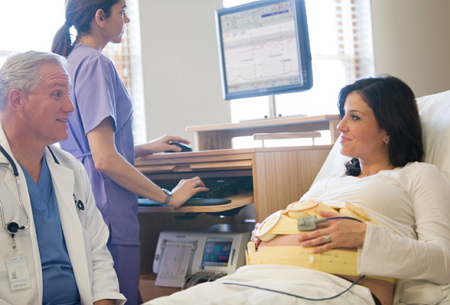Fetal Heart Rate

Contents:
- Normal Fetal Heart Rates
- Terms of Detection and Normal Heart Rates of a Fetus by Weeks of Gestation
- What is the Most Informative Method of Diagnosing of Fetal Heart Tones?
- Can You Listen to the Heartbeat at Home?
Normal Fetal Heart Rates
The heartbeat of an unborn baby is the most pleasant and long-awaited sound for a pregnant woman. It means the beginning of a new life, hopefulness and joy of the future motherhood. However, in addition, the heartbeat of your child can tell a lot about his health.
Terms of Detection and Normal Heart Rates of a Fetus by Weeks of Gestation
It is possible to detect the heartbeat of a baby at the early stages. Using a conventional abdominal ultrasound sensor, a doctor detects heart beats at the 5th week of pregnancy, and a vaginal probe will make this already on the 3d-4th weeks, i.e. almost immediately after the first little heart beat.
The fetal heart rates vary not only according to the activity of fetus, but also changes with gestational age:
- at the 6th-8th weeks, heart rates are 110-130 per minute;
- from the 8th to the 11th week, they can increase up to 190 beats per minute;
- starting with the 11th week, they can hold in the interval of 140-160 beats per minute with small variations.
Your doctor assesses not only the heartbeat condition of a fetus on a weekly basis, but also takes into account additional factors (diseases of a mother and her child, the time of listening and the phase of your kid's activity).
What is the Most Informative Method of Diagnosing of Fetal Heart Tones?

There are many ways to monitor the work of the heart of the fetus, and each of these methods has its own advantages.
Listening by a Fetoscope
This is the simplest and the most accessible way to determine fetal heart rates. The fetoscope is a simple funnel. In order to hear the heartbeat, a wider part of the funnel should be pressed hard to the anterior abdominal wall. Such a simple method is effective only from experienced obstetricians.
To listen heart tones, you need to know where exactly to put the stethoscope. To do this, doctors undertake a study of the outside position of the fetus before an auscultation: they define the presentation (of the part situated to the small pelvis), the position (a position of the back to the right or left) and the view (the turn of the back forward or back) of the fetus.
Cardiotocography
Cardiotocography is a method for recording of the fetal heart using an ultrasound sensor. The obtained from the sensor data are converted on a heartbeat monitor into heart rates that appear on paper in the form of a graph.
This method is very good due to the fact that the record can be very long (about an hour, and more if necessary), and you can assess the work of the fetal heart for all this time. In addition, the undoubted advantage is the simultaneous registration of uterine tone by the second sensor.
The Ultrasound Investigation (U\S)
The method of ultrasound investigation is very informative, the undoubted advantage is its ability to monitor the heart rhythm at the early stages of pregnancy, when other ways are inefficient. Thus, in the first half of pregnancy, it is the only method of evaluating the performance of the cardiovascular system of a fetus. In case of uncomplicated pregnancy, ultrasound examination is conducted three times at the appropriate time (at 10-12 weeks, 21-23 weeks, 31-32 weeks).
The score of the heartbeat rhythm is conducted in conjunction with other important research studies. However, in the circumstances, it is possible to explore the frequency of cardiac contractions, as well as to conduct certain non-stress tests more frequently (for example, in case of fetal hypoxia, violation of the utero-placental blood flow) in order to monitor the status of a fetus in the dynamics and to compare the obtained results with previous ones. Often, such research is carried out after a specific treatment to evaluate the effectiveness of the therapy.
Сardiointervalography
This method is used very rarely; and it is required only in cases when it is necessary to examine the details of the baby's heart beat in contentious situations or in case of a severe pathology. This technique is in an ultrasound registration of the heart activity over a long period of time (not less than 60 min).
Can You Listen to the Heartbeat at Home?
Some parents wonder whether they can hear the baby's heartbeat at home without going to a specialist using an ordinary usual phonendoscope. Of course, you can use this method. But be ready that on the 21st-22nd weeks you will not hear a heartbeat. In addition, you will need to be able to distinguish fetal heart beat from other sounds: the abdominal aorta pulsating of a pregnant woman, intestinal peristalsis.
On average, the fetus`s heart beats 1.5-2 times more rapidly than of his mother`s. For your convenience, you can simultaneously count the pulse of the woman, not to confuse the rhythms of her heart with her baby`s heart rates.
How to Listen to Fetal Heart Sounds – Fetal Heart Rate & Heart Beat.